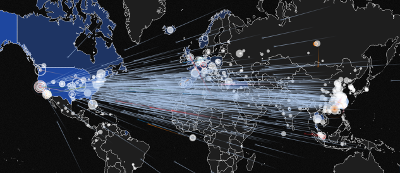Denial of Service (DoS Attack) or Distributed Denial of Service (DDoS attack) is still a hot topic in 2016 even though it was discovered in 1994 and began being seen in the wild in September of 1996. There are many solutions that counter these attacks via on premise and off premise solutions. Let’s expand on on-premise solutions.
A DoS attack is an attack that is not necessarily volumetric in nature. Instead is it focused on overwhelming the on premise gear but not saturating the full internet pipe. A good example of this would be a syn flood that fills up the connection table on your firewall. I know what you are thinking, “But Brian, we have a NGFW that is capable of moving 40Gbps!” but let’s look at this a bit closer. Yes, your firewall is capable of moving a 20GB file but what happens if you break up that 40GB into millions of connections? The real attack vector here is not throughput, it’s connections.
Connections per second (CPS):
Connections per second (CPS) refers to the rate at which a device can establish state parameters for new connections. A stateful device must create and manage connection information on all unique IP streams that transit the device. Typically, the device must handle the first packet of a new connection differently than all subsequent packets so that the device can establish the state parameters for the new connection. Because this process is specialized, it usually occurs in the software process of the devices, as opposed to the normal hardware-based forwarding process.
What firewall administrators usually do not do is to check the max CPS numbers their Internet facing link can carry. This number depends on the Internet link speed. It is the same number as the max frames per second a link can carry. Frames per second is calculated as following:
(Link speed)/(84 Byte * 8bit/Byte) = max frames per second.
Each frame can be a new connection (UDP), therefore max FPS = max CPS Here an overview of how many CPS a link can transport related to link speed:
| Link Speed | Max CPS |
|---|---|
| 100 Mbps | 148, 809 |
| 1,000 Mbps (1Gbps) | 1,488,906 |
| 10,000 Mbps (10Gbps) | 14,880,960 |
Maximum Concurrent Connections (MCC)
The number of concurrent connections is directly related to the max CPS number. When a Firewall hits it’s concurrent connection limits it does not accept new connections for any service and all services behind this firewall are not accessible for new requests. This number shows also the time a DDOS attack needs to take a firewall down and also the time the firewall has to take countermeasures against the attack. If for example, a firewall processes a DDOS mitigation run every 30 seconds but the firewall is overloaded in 10 seconds then it is too late for countermeasures.
So, why does it bother me? My Firewall does 40Gbps!
Well, what firewall vendors advertise is the throughput of the system for transferring large files. Unfortunately DDOS attacks do not use regular traffic. The frontend Internet facing firewall should be designed to handle the Internet facing threat potential. This is the reason why Administrators do not choose a 200 Mbps firewall to protect against a 1 Gig link. The same sizing guides should be taken into account for CPS.
Action Item for you: Go to your Firewall vendor product specification list and check the CPS numbers they publish.
What is the result?
Your Firewall cannot protect you. Even more: even if you upgrade to the strongest appliance model your Firewall vendor offers, it will not protect your datacenter because it can not handle the CPS threat. Please note, this post isn’t here to pick on your current firewall. At the end of the day, these are complementary solutions. Most likely you did not buy your NGFW for DoS/DDoS mitigation however advertised speeds tend to give a false sense of security.
Here are some real life examples (state of Dec 2015):
Please note: all the Firewalls are High End Firewalls and partially marked as Carrier class devices, which means, they are also priced as carrier class devices.
How do I protect my perimeter firewall?
F5 is the only vendor that offers high speed Firewall protection at midsize appliances. Here an overview of possible F5 Firewall solutions:
It’s interesting to note that 5250v (smallest appliance) is only a 2U that is capable of cleaning just about anyone’s internet circuit. I am unaware of anyone in the southwest with pipe greater than 20Gbps.
Do I migrate my existing perimeter firewall to a F5 firewall?
In short, no. A F5 System could be installed in parallel with the existing Firewall. However, in recent efforts, I have deployed the F5 as a L2 Transparent DoS/DDoS mitigation device in front of the existing firewalls. The draw for this is the deployment is simple, easy to manage, you keep your existing policy on your firewalls, and utilize the F5 for mitigation only.
Credit: Vladimir Bojkovic
In 2015, I personally worked on two projects where customers used the F5 as a L2 Transparent DDoS mitigation device after suffering outages.
Project #1: Customer had a pair of PA-7050’s( App ID and Threat Detection enabled) on the perimeter and a 1 Gbps internet circuit. They were hit with a NTP reflection attack that caused an outage and the Palo Alto boxes to fall over. Post mortem, the NTP reflection attack was on 230 Mbps in size but exhausted the CPS on the PA. For those of you wondering, the box only had 478 Mbps running thru it at the time.
We positioned the 5250v box at the perimeter for mitigation. Currently the network and security team sees the F5 as their first line of security for any and all L3/L4 attacks.
Project #2: This customer has a mixture of technologies in their environment which lead to a false sense of security. At the perimeter, they had Cisco 5585-40’s along with 20Gbps internet circuits. Early in the fall, they were hit with a 3Gbps TCP SYN flood (3 million unique client IPs) that took the down the PA’s.
We positioned the VIPRION B2250 as a L2 transparent DDoS firewall. The beautiful part of this solution was, it went directly into production and it did not associate a single helpdesk ticket; it truly went in as a bump on the wire.
If you have any questions or comments, feel free to leave your thoughts below.
Regards,
BD

